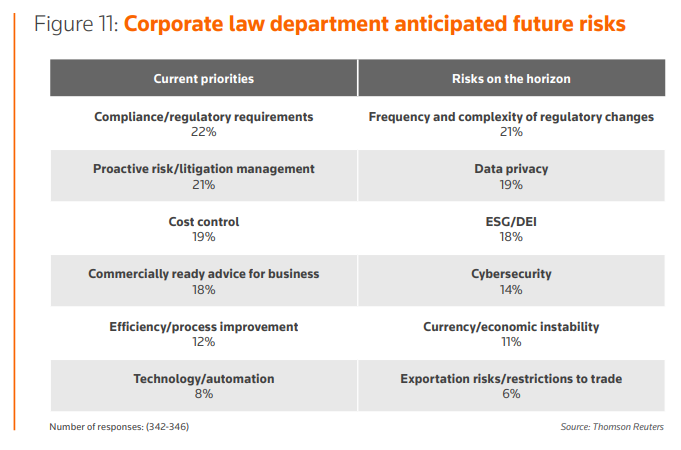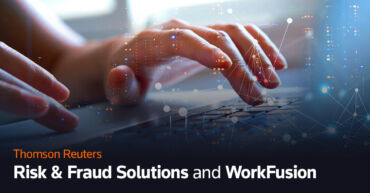Leveraging AI is critical for effective risk management and maintaining compliance in today's complex business landscape.
 | 2023 Future of Professionals ReportHow AI is the Catalyst for Transforming Every Aspect of Work |
Jump to:
| Insight: Risk management a top priority |
| AI and compliance |
| AI and fraud |
| AI and data quality |
| AI and analysis |
| Final words |
A far cry from just a buzzword, artificial intelligence (AI) is increasingly proving its importance and ability to drive change within companies across all industries, especially generative AI (GenAI). This includes mitigating risk and better risk management among organizations in a complex and ever-changing regulatory environment.
Looking to help forward-looking businesses better understand the role AI can play in identifying and mitigating risk, the Thomson Reuters Future of Professionals report surveyed more than 1,200 individuals working in the tax and accounting, legal, global trade, risk, and compliance fields.
Insight: Risk management a top priority
Better risk management is a concern for today’s businesses, especially among those operating within highly regulated industries. In fact, survey respondents within both corporate tax and legal functions highlighted risk identification and risk mitigation as a top priority. And for good reason.

Highly regulated industries can be subject to regulations at several levels, such as geographic location and levels of government, and keeping pace with change can be challenging. Falling out of compliance can not only be detrimental to an organization’s reputation, and possibly inflict damage on its customers, but it can also result in hefty fines and penalties.
To help navigate the complexities, such businesses have historically employed compliance teams and dedicated experts. Unfortunately, this model is becoming increasingly difficult due to strained bandwidth and the desire to reduce costs.
Furthermore, external concerns like data breaches, cyber-attacks, AI risks, and volatile geopolitical issues also require significant resources to help safeguard a business. Augmenting staff with the right tools and resources is critical.
As a result, a growing number of organizations are turning to AI to augment staff and help assist them in risk-related work and, ultimately, avoid or reduce fines and penalties.
According to the report, professionals said improving risk identification and mitigation whilst reducing tax audits and penalties are top areas where AI can help, as well as keeping abreast of regulation and legislation, and also enhancing their fraud prevention and detection abilities. Let’s take a closer look.
AI and compliance
The use of AI can play a pivotal role in helping businesses stay compliant with various regulations and industry standards. By leveraging the power of machine learning and natural language processing, AI systems can identify potential compliance risks and provide actionable insights to mitigate those risks. This is also useful when it comes to regulatory compliance and staying on top of ever-changing laws.

One of the key areas where AI can assist is in document management and review. AI algorithms can quickly scan through contracts, policies, and other legal documents to identify potential compliance issues, such as missing clauses or outdated language. This can significantly streamline the compliance review process and reduce the risk of human error.
Additionally, AI can be used to monitor employee communications, transactions, and other activities for potential compliance violations. By continuously monitoring data streams, AI systems can detect anomalies or patterns that may indicate non-compliance, allowing businesses to take corrective action promptly.
Furthermore, AI can help businesses stay up-to-date with changing regulations and industry standards by continuously monitoring relevant sources and providing timely updates and recommendations for compliance adjustments.
AI and fraud
Leveraging AI to drive the efficiency and effectiveness of fraud prevention and detection is also critical for today’s businesses. This could help plan and solidify risk management and risk assessments for many organizations.
In fact, when professionals in in-house departments were asked in the Thomson Reuters survey how AI can help protect their business internally, fraud prevention and detection was cited as a leading benefit.
Historically, uncovering fraud and risk has been a time-consuming, manual process that is vulnerable to human error. With the introduction of AI-powered tools, businesses can more easily analyze anomalies and patterns and identify where bigger challenges, like fraud or cybersecurity challenges, exist while using AI responsibly.
To further illustrate, the report mentions that AI can help professionals with fraud prevention and detection by using machine learning to monitor suspicious activity and flag anomalies, such as unusual patterns of payments, invoices, anti-money laundering (AML), or claims. This will be useful for compliance officers and compliance professionals who delve into processes for Know-Your-Customer (KYC).
Leveraging innovative risk technology to detect, prevent, and mitigate fraud is critical for organizations in today’s challenging business environment that is fraught with both internal and external risks.
 | Future of Professionals ReportHow AI is the Catalyst for Transforming Every Aspect of Work
|
AI and data quality
As the adage goes, data is king. This is true if it is quality data. Too often businesses are trying to gather data in disparate forms from numerous sources. This is not only highly inefficient but it also increases the risk of unclean data and errors.
Fortunately, today’s organizations are not powerless. By leveraging AI, they can further unlock the power of data and discover insightful metrics. AI in accounting may not be new but there’s no doubt that a seismic shift is underway as more and more businesses take a closer look at how they can apply AI and help ensure they have access to quality data.
For example, if an organization’s client has numerous accounting systems, all containing different sets and types of data, it presents potential challenges for auditors. It’s important for businesses to be aware of data protection.
Within tax functions, professionals who were surveyed said that AI can help reduce tax audits and penalties through improved data quality and the identification of trends in transfer pricing. Consider the vital role that AI can play in audits. AI enables auditors to analyze vast amounts of data and quickly identify anomalies and patterns in a way that a human cannot. This means auditors can move away from sampling and shift toward reviewing all of a client’s transactions in real time.
In short, when businesses have confidence in the quality of their data, they can make more informed business decisions, while mitigating risk and avoiding the threat of errors and penalties.
AI and analysis
AI advancements are also proving beneficial in data analysis. AI models, for instance, can detect patterns that identify potential risks of losses that could occur based on analysis of large amounts of data, including contracts.
This automation can be game-changing for organizations losing money and missing out on business opportunities due to contracting inefficiencies. In fact, research has shown that contracting is rarely done efficiently or effectively. Why? It is tedious work that requires the combined skillset of legal expertise and the ability to interpret legal language.
Paragraphs written differently may mean the same thing, and, on the flip side, written paragraphs with a single word changed can entirely alter the meaning. Keeping it all straight can be difficult. Furthermore, professionals must translate jargon language into business language for their clients and then assess the risks.
Fortunately, AI-powered tools for documents can help automate some of the tedious aspects of the process and identify pertinent information from hundreds or even thousands of documents in just a matter of minutes. Once data is extracted, it can then be used in several ways. For example, a lawyer may want to see data visualization or analytics for a large group of contracts.
In summary, AI-powered technology enables businesses to spend less time searching for information from contacts and more time acting on it. It also helps with mitigating risk, greater risk management, identifying trends, and better decision-making.
Final words
In today’s fast-paced and highly regulated business landscape, maintaining compliance and effectively managing risk is paramount. However, the traditional methods of relying solely on human expertise and manual processes are no longer sufficient. By embracing the power of artificial intelligence, businesses can gain a significant competitive advantage in navigating the complexities of compliance, fraud detection, data quality assurance, and risk mitigation.
Overall, leveraging innovative AI is critical for effective risk management and maintaining compliance in today’s complex business landscape rife with internal and external threats.
Don’t let your business fall victim to the perils of unclean data, missed growth opportunities, and fraud. Take action now to safeguard your business and avoid potential fines and penalties. For more information and insights, explore the Future of Professionals report.
View the interactive infographic |
|












